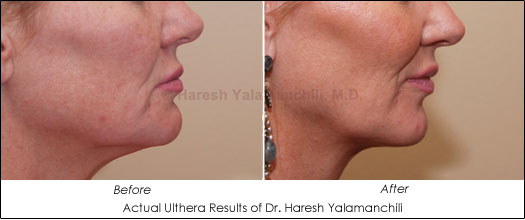As we age, one of the first things to go is skin elasticity. Skin that was once smooth and supple begins to feel looser and sag so it's not surprising that one of the most popular procedures today is skin tightening. In the past, addressing lax skin was only possible through surgery with a facelift but new technology has made it possible to tighten skin without ever going under the knife.

Actual Ultherapy Results of Dr. Haresh Yalamanchili
One such device, Ultherapy uses ultrasound combined with DeepSEE technology which allows the physician to actually visualize the depth at which treatment is occurring, allowing more precise treatment to offer a lifting effect. "There are many skin tightening devices available that focus on the superficial layers of the skin - treating fine lines, skin damage and even some skin laxity," states Houston facial plastic surgeon Dr. Haresh Yalamanchili, "However, Ultherapy appealed to me as a surgeon because it addresses the deeper foundation underneath the skin - the muscles and deep connective tissues - similar to what a physician is doing with surgery."
According to Dr. Yalamanchili, Ulthera uses ultrasound energy to stimulate the natural growth of collagen, which is responsible for skin elasticity. "Ulthera does cause contraction in the underlying muscle layers and connective tissues but each place that you administer the energy, more collagen will eventually grow, giving patients the lift they're seeking," describes Dr. Yalamanchili, "While the FDA indication for Ulthera is to lift the brows, off-label, we're seeing more definition at the jawline and nice lifting in the mid face and cheek area."

Actual Ulthera Results of Dr. Haresh Yalamanchili
Unlike other skin tightening devices, Dr. Yalamanchili points out that Ulthera has a different end-goal in terms of what patients should expect. He says, "We're treating the effects of gravity: sagging skin as opposed to fine lines, wrinkles, or brown spots. There are many options available to treat those aforementioned signs of aging but Ultherapy is the one of the few non-surgical options available that actually addresses the effects of gravity, lifting the skin for a more youthful appearance."
As one of the first providers to offer Ulthera, Dr. Yalamanchili has had substantial experience with the procedure. And while patients in their 50s and 60s may get results with the procedure, it appears the group that benefits the most from Ulthera are patients in their late 30s to early 40s, those who are just beginning to see the effects of gravity on their skin.

Actual Before and After Photos of Ultherapy by Dr. Haresh Yalamanchili
"The first signs of aging are the eyebrows and the cheeks begin moving southward in your late 30s and early 40s. Ulthera works by stimulating your body to grow new collagen and to tighten up some of the deeper structures and the results are really dependent on how well your body can do that," states Dr. Yalamanchili, "Naturally, our bodies are much better at growing collagen when we're younger. We're finding that patients in their 30s and 40s are getting a more consistently robust response for the same amount of treatment compared to someone who is older."
Dr. Yalamanchili remarks that for these patients, the results of Ulthera work as a refresher, one that actually lifts the brows up a few millimeters, opening up the eyes and bringing up the cheeks a bit to help treat the beginning signs of hollowness. The difference could be between looking tired and not sleeping well vs. looking well rested and energetic, which is the results he is seeing for this particular age group.
"There is one school of thought that if patients are tightening things back up to where they were a few years ago - before there's an actual dramatic drop - it's a preemptive move to postpone a more invasive procedure, for example, surgery," explains Dr. Yalamanchili, "This is a trend that we're seeing in cosmetic medicine in general, younger patients getting 'preventative' procedures who come back every year and a half to two years for a maintenance treatment to put off having to get a bigger procedure that may involve going under the knife."

Actual Before and After Photos of Ulthera by Dr. Haresh Yalamanchili
Different from when he first started performing the Ulthera, Dr. Yalamanchili says that as he has worked with the technology more, he has increased the ultrasound energy to get better results with one treatment. " Initially, when the device was first being introduced, the protocol was pretty conservative in the sense of how much energy to use during the procedure," explains Dr. Yalamanchili, "What we found is the more energy you could deliver to one area, the more collagen is being stimulated to regrow. Now, we have nearly doubled the energy that we initially started out with and patients are seeing an increase in quality of results in one treatment that may have taken 2 treatments previously."
Dr. Yalamanchili stresses that while Ulthera may offer a minor lift - up to 5 or 6 millimeters, it does not take the place of surgery. For patients who have severe skin laxity, Ulthera may not offer the amount of tightening they desire. However, for patients with mild skin laxity, Ultherapy just may offer them a non-surgical option to achieve a fresher, more youthful look.